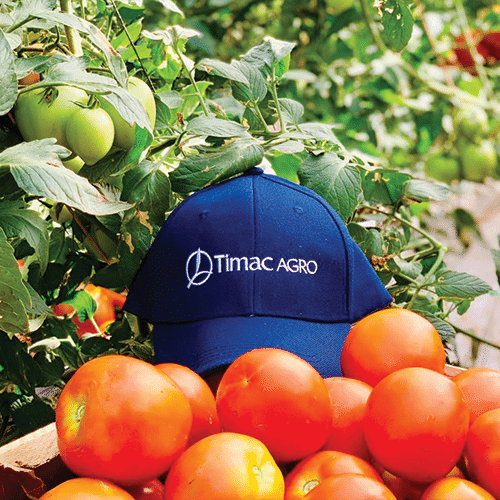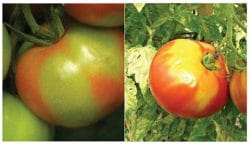Potassium Dynamics in Vegetables >>

Potassium Dynamics in Vegetables
As growers, understanding potassium as a key nutrient for plant health and fruit quality is critical for maximizing vegetable crop success. Potassium is associated with the movement of water, nutrients, and carbohydrates in plant tissue. It’s involved with enzyme activation within the plant, which affects protein and starch production. Potassium also helps regulate the opening and closing of the stomata, which regulates the exchange of water vapor, oxygen and carbon dioxide. Potassium has a well-researched role in plants’ resistance to biotic (disease) and abiotic stresses (temperature, water, drought). If K is deficient or not supplied in adequate amounts, plant growth will be stunted, and yields will be negatively impacted. Common K deficiencies can result in fruit quality issues such as yellow shoulders and gray wall in tomatoes.

Potassium Deficiency in Tomatoes
Most growers are putting anywhere from 200-400 lbs of potassium in the pre-plant bedded fertilizer blend. However, given soil conditions, upfront granular fertilization is frequently not enough to maintain adequate fruit and tissue levels throughout the season. Uptake of soil potassium (K+) can be negatively affected by other cations in the soil. Calcium (Ca+2) and magnesium (Mg+2) are the main cations that compete with potassium on the exchange sites of the soil. If there is an excessive amount in the soil solution, potassium uptake will be reduced.
Fertigation and Foliar Potassium
The plant itself has incredible K demands during reproduction. Trials have shown potassium amounts in one tomato fruit can increase 4x in a 4-week period and at the same time, the plant multiplies the fruit per plant by 5x. This is where fertigation and foliar potassium can be used as tools to supplement during times of peak demand. It is important to take into account irrigation water pH can inhibit potassium uptake. Many growers irrigate from sources that have high pH and alkalinity. Tomatoes and peppers pull in the most nutrients at a soil pH of 6.2-6.5. If irrigation water is much higher than that, acidification measures should be taken (remember pH is a log scale and a 1-point difference is a 10x factor).
To help keep up with demand, we recommend drip applying KSC® 8-16-42 at increasing rates depending on leaf tissue samples. KSC® is a low EC water-soluble fertilizer that contains our patented Phytactyl Complex to improve nutrient uptake. In tomatoes and peppers, we want potassium levels to be above 3% to produce the best quality fruit and maintain new blossom sets. Corresponding Calcium levels should run around 3% with Magnesium at 0.8-1%.
Our years of experience working with growers’ leaf tissue tests have shown that potassium can be stored in the plant early before times of high demand. Potassium is a highly mobile nutrient. Therefore, it can be stored in the lower leaves and then translocated. Cloudy weather and dry soil conditions can reduce nutrient transport in the plant. Foliar applications of potassium can help during these stressful periods. FERTILEADER® Elite can be used as a tool because it contains the Seactiv® Complex that aids in stress reduction and increases nutrient translocation in the plant. It contains K, Ca, and B. Understanding and planning for the crops’ nutritional needs, utilizing the right tools, and starting your potassium strategy early will help you stay ahead of the immense potassium demand.
Author: Jordan Martin – Northeast Business Director
CLICK HERE TO TALK TO A TIMAC AGRO EXPERT
